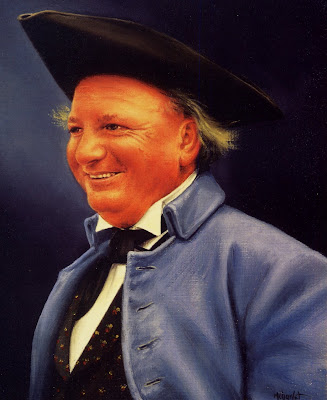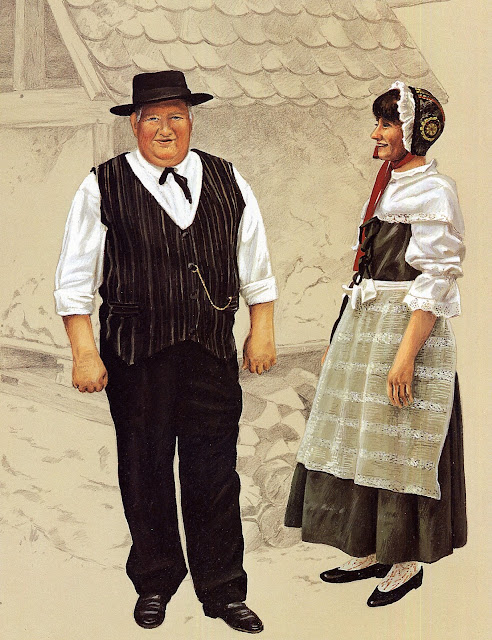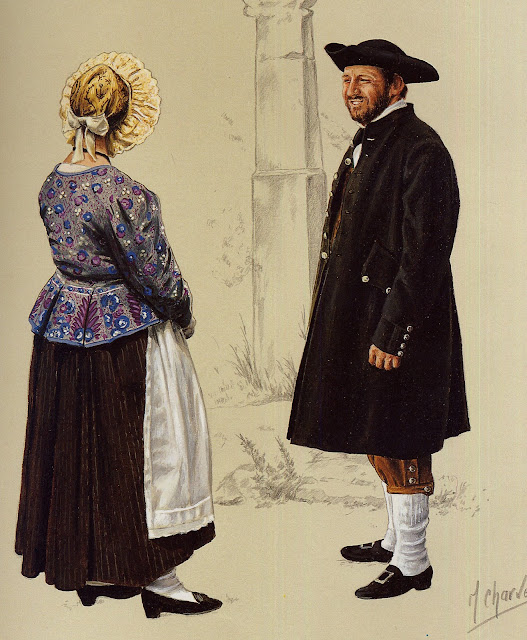Hello all,
Today I will spend some time talking about the various costumes of Alsace or Elsass.
This image above shows some of them from the north half of the province. Here is a map locating Alsace within France, and the flag of Elsass.
This region has been fought over by France and Germany for a long time, being in a strategic location on the west bank of the Rhine. It has been an integral part of France since the treaty of Versailles, but the ethnic origin of the majority of the people is German. The traditional language of most of the people in Elsass is a dialect of Allemanisch, with the exception of some of the valleys in the Vosges mountains in the west of the province, the so-called Welschlands. These people are not Cymry; 'Welsch' in old German means 'people whose language we don't understand', which is why the Anglo Saxons in Britain used it to refer to the natives there as well. 'Wend' is the equivalent term in the east Germanic dialects, which was used to refer to the Sorbs and Slovenes. These 'Welsch' spoke French dialects from Lorraine.
German, mainly for political reasons is considered to be one language. However it actually consists of a large number of very dissimilar dialects which linguists group into four languages: Lower German, Platt, or Niederdeutsch, Central German or Mitteldeutsch, Upper German or Oberdeutsch [Boarisch], and Allemanisch. Allemanisch dialects are spoken in Switzerland, Vorarlberg, Baden, the Schwartzwald, Elsass, Lorraine, Franconia and Swabia. [Upper German should not be confused with High German, Hochdeutsch, which is the literary language of all of Germany, Austria and Switzerland]. Here is a linguistic map of the traditional languages of Alsace.
Today, because of draconian measures by the French government, about 40 percent of the adults can speak Alsatian, but only 3 percent of the children. There is a move to revive the language, however, and I wish them well. For more information on Alsace, see this article.
http://en.wikipedia.org/wiki/Alsace
This province is very rich in folk dress. From the point of view of Folk Costumes, Elsass can be divided into 6 regions. The small map has the regions outlined in color, and the large map can be blown up to read the place names.
Region 1. Wissembourg. This is in the far northeast, and is bounded by the light blue line in the first map.
While the majority of Elsass is Lutheran, there are islands of Catholics as well. As in many Germanic areas, the two communities are often distinguished by costume. There has historically been little friction between the two. The villages of Schleithal and Oberrœdern are two such islands. The costume of the two is very similar, but in Schleithal they wear white bonnets, while in Oberrœdern the bonnets are pale blue.
Slightly to the west are the villages of Hunspach, Hoffen, Ingolsheim and Seebach [Oberseebach]. This area is majority protestant and shares a single costume. Single girls wear a small cap which is wrapped around with a red ribbon knotted in front. Married women replace this with a black ribbon knotted in back that has the ends trailing. At the same time the red flowers on the fichu and apron are replaced with white. The plastron of this region is ornamented with a relatively small amount of embroidery and a large silk bow.
Originally the cap was of brocade or adorned with rich gold embroidery, and was trimmed by a ribbon wrapped around the brim and tied in a bow in front.
In the period from 1830 to 1880 the bow got progressively larger, to the point where it is no longer actually tied, but folded into shape and held by a ribbon in the center. The ornament on the cap itself is now restricted to the crest in back, the only part not covered by the bow.
In the majority catholic areas of Haguenau and Geispolsheim, unmarried girls wear red bows.
In the catholic area of Kochersberg, unmarried girls wear bows of many colors, silk plaid, brocade, or of a single color with floral designs printed, painted, or embroidered on them. The tails tend to be longer.
Let's see them all together
Over this region the men's costume tends to be similar, with many buttons.
Region 3. Lower Alsace. This is in the east of the province, shown bounded by the amber line in the small map. This includes the lowlands along the Rhine river. This area has quite a variety of costumes, many including an elaborately decorated gold cap.
Some feature a bonnet with ribbons tied under the chin. Just a very short presentation of a number of costumes, north to south.
Westhoffen
Bischoffsheim. This bonnet is also worn by young girls in neighboring areas of the Strasbourg area as the winter bonnet.
Obernai.
Meistratzheim. This area has a suncap of lace to rival that of Boulogne.
Colmar
Boutzwiller by Mulhouse
Region 4. Sundgau. This is in the highlands of the far south of the province. It is bordered by a dark blue line on the small map.
Illfurth
Dannemarie
Region 5. Upper Alsace. This consists of the highlands of the western part of the province. This is the area to the left of the amber line on the small map. This includes the Welschlands. [Sundgau is technically part of Upper Alsace, but I am dealing with it as a separate region.]
Munster valley. Many of the people of this area are descended from Swiss settlers. This is evident in the costume. The women wear a small cap with a an ornamental ribbon around the edge, which forms a small rosette over the beak in front. There are earflaps on the sides with ribbons which tie under the chin. These are called dalwiwala.
The woman on the left in this photo is from the neighboring valley of Soultzeren.
The Welschlands. These are people who are traditionally Francophone, as can be seen from the place names; and whose costume belongs rather to the tradition of the Vosges and Lorraine.
Girl from Lapoutroie
Man from the Bruches valley.
Couple from Grandfontaine.
Region 6. Alsace Bossue. This is the arm of Elsass which extends to the northwest. It is geographically part of the plateau of Lorraine, but is traditionally attached to Alsace because of its majority Lutheran population, whereas Lorraine is majority Catholic.
Here are some videos of dance groups in the costume of the Hanau area.
https://www.youtube.com/watch?v=ZGQYzzJqn1A
https://www.youtube.com/watch?v=m3vd9zl2yoA
Feel
free to contact me with requests for research. I hope to eventually
cover all of Europe and the Former Russian Empire/Soviet Union. I also
gratefully accept tips on source materials which i may not have. I also
accept commissions to research/design, sew, and/or embroider costumes
or other items for groups or individuals. I also choreograph and teach
folk dance.
Roman K.
Source Material:
Marguerite Doerflinger, 'Decouverte des Costumes Traditionnels en Alsace', Colmar, 1979
Michel Charvet, 'Coiffes et Costumes d'Alsace', Strasbourg, 1997
Frantisek Zvardon, 'Les Alsaciens', Strasbourg, 2009
Philippe Legin, ''Toute L'Alsace - Coutumes et Costumes Alsaciens', Colmar, 1993
Charles Spindler, 'Costumes et Coutumes d'Alsace', Colmar, 1975 [reprint]
Caroline Brancq, 'Les Costumes Regionaux d'Autrefoix', Paris, 2003















































































dear roman! since i discovered you blog i always enjoy you posts.
ReplyDeletethank you for this great work!
thank you for your encouragement
DeleteLikewise, I also found it extremely helpful.
DeleteI just discovered this blog today and I DEVOURED it, and will be coming back next week to pore over it some more. I love these articles and I love you for writing them and please keep up this blog forever and ever and ever.
ReplyDeleteRomane, do you Fr. Hottenroth in your collection of reference material? He provides drawings of Alsatian costume (Tracht) from a German perspective, and differentiates as costume evolved over time, confession, and occupation. Some material is available online https://play.google.com/books/reader?id=wE4oAAAAYAAJ&printsec=frontcover&output=reader&authuser=0&hl=en&pg=GBS.PA75
ReplyDeleteHello Roman,
ReplyDeleteJust as the previous comments, I've discovered your blog this morning and I couldn't be any happier! I'm impressed by the rigour of your research. I've already subscribed to your blog.
All the best.
Thank you so much for making this great resource available! I was also very happy to find it for my costume research.
ReplyDeleteThis was exactly was I was looking for! Thank you!
ReplyDeleteThis was exactly was I was looking for! Thank you!
ReplyDeleteI am glad that you found this helpful
DeleteWait that actually did wear clogs? I thought that was just remaindering when I was trying to break out of the unfortunate habits I had when writing my earlier books.
ReplyDeleteI knew clogs weren't just a dutch thing, I didn't know they were so pervasive.
Also those black dresses ... cute!
Was the dominant fibre for the skirts wool? Susan
ReplyDeleteI would say so, yes. But it is clear in some of the images that the skirt is silk or cotton. Everyday skirts are usually cotton, as are the printed ones. Some of the dress skirts are silk.
Deletecould it be that wool was predominant in cooler weather for every day dress?
ReplyDeletei had no idea there were so many different costumes, i grew up in Saverne and left for the US when i was 18, i continue to discover interesting facts i didnt know when i was growing up. thanks for this fascinating post.
ReplyDeletewhat is the history of the red/white and blue circle on the big black headdress?
ReplyDeleteThat is the French Cockade. It is based on the current French Flag. It is worn to show allegiance to France, rather than Germany, even though most inhabitants of Alsace are of German origin.
DeleteWonderful blog and information !
ReplyDeleteHi Roman, just discovered this and great read! I was wondering if you could find costumes from the village of Soultz, where my grandmother is from. Did they where clogs and where could I purchase a headdress in Soultzian fashion? Thank you. RENEE
ReplyDeleteHI! Wondering where you are located. Also, I want to make the little black vest for my daughter for preschool on Friday and am wondering what it might be called? (Our ancestors are from the Zoebersdorf region of Alsace-Lorraine)
ReplyDeleteSuch a nice information . I love your blog , You can : :
ReplyDeleteVisit us Most popular German brands Store : http://germanbavarian.com/
Really beautiful and informative. My ancestor immigrated to US in 1860s we believe from Wissembourg. So much diversity in costume!
ReplyDeleteJust visited Strasbourg for the first time and was curious about the large black bows worn by the women in old pictures. I found your fantastic blog and it answered my questions as well as giving me so much more to think about. Thank you!
ReplyDeleteI really enjoyed this article. I haven't been to this region of France but I am writing a novel about the sculptor Bartholdi, whose hometown was Colmar, and this article with its wonderful images and maps will flesh out an entire scene. Thank you.
ReplyDelete